Course:GEOS303/2022/Socotra
| Map of the Socotra Archipelago |
|---|
| The islands of the Socotra Archipelago off the Horn of Africa, near the Gulf of Aden |
Socotra or Soqotra, is the main island of the Socotra archipelago, composed of four islands, South of the Arabian Peninsula. The climate of the island is arid with vegetation types that are strongly related to elevation and soil type, and forming ecozones ranging from low-lying coastal grasslands to high woodlands. Geographic isolation for the past 18 million years has preserved pre-Miocene ecology while genetically isolating many species from their mainland counterparts allowing for high endemism, especially in plants, reptiles, and land snails. Socotra has been continuously inhabited for millennia by the local Soqotri people with relatively low ecological impact on their environment until the introduction of the island into the larger trading network of the Arabian peninsula. The introduction of goats to the island along with the exportation of resin from the native dragon blood trees have led serious environmental degradation, which has continued to increase into the 20th century with rapid economic development on the island. With the designation of the island as a UNESCO World Heritage site, many parties seek to protect the unique nature on the island to preserve the island for future generations while others seek to preserve the island for use as a new ecotourism hotspot.
Biogeography

The island is situated northwesterly of Somalia and to the south of the Arabian Peninsula, 320 km from the coastline of mainland Yemen. Socotra is the largest of the four islands found the in the Socotra archipelago. Although limited climatic research is available for Socotra, the dominant biome is conclusively desert. Socotra features an arid tropical climate with an average temperature of 24.8-31.1ºc and an annual precipitation rate of approximately 200 mm a year. Variability is dependent on the island’s complex topography, monsoon seasons, Inter-Tropical Convergence Zone and orographic lift, all which may increase or decrease the annual precipitation approximation. The island can be further divided into three dominant ecoregions. Limestone plateaus are the most prevalent in regions situated at an elevation range of 300-700 m and characterized by karst drainage features, especially in the forms of accentuated gullies, caves and sinkholes. This ecoregion tends to be poorly vegetated in consequence to the exposed limestone; however, some groups of plant species may tolerate these conditions such as bryophytes. Several bushes and Dracaena cinnabari, known as dragon blood trees, are also found in this region. The Hagghier Mountains differentiate to the limestone plateaus for their pockets of fertile soil, granitic composition, and high elevations peaking above 1000 m, the highest reaching 1,550 m. In areas where the limestone plateaus do not contact the coast, coastal plains dominate at varying lengths. White coral sands characterize the coastal plains[1].
Vegetation Zones
Subdesert shrub and grass compose the island’s dominant ecology, followed by subdesert shrub characterized by the tree species Boswellia Bracanae; however, vegetation zones dependent on elevation and ecoregion may be further distinguishable. An analysis on Socotra’s dominant ecologies resulted in a categorization of 0 to 200 m, 200 to 400 m, 400 to 1000 m, and exceeding 1000 m to each have distinct plant communities. Between 0 to 200 m, coastal plains predominately feature Dactyloctenium robecchii and Aristida adscensionis- Tephrosia apollenia grasslands on a limestone substratum. The next zone of 200 to 400 m functions as a transition zone between the alluvial and limestone substratum, moving from arid coastal plains to the arid plateaus and hills situated between 400 to 1000 m. In this zone, bare limestone rocks dominates and so Buxanthus pedicellatus and Croton sarcocarpus shrublands along with Panicum atrosanguineum grasslands are most common. At the highest range of 1000 m and higher, Trichodesma scottii- Cephalocroton socotranus, a woody shrubland is characterizable to the region[2].
Limitations
The island is of continental origin composed of carbonate rocks dating back to the Triassic to Miocene period. Before splitting from the mainland, Socotra was part of the African plate, diverging from current-day Oman due to the breakage of the Arabian-Nubian shield[3]. Socotra’s geology has resulted in various biogeographic and biophysical limitations. Due to the island’s isolation, several species can only be found within the archipelago resulting in a high degree of endemism. The island’s size reduces the risk of sea level rise and the coastline experiences minimal change, though, erosion has been observed at Detwah Lagoon[4]. Climate change may result in Socotra becoming increasingly more warm and wet as the crisis persists.
Diversity
Aquatic
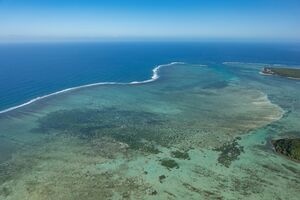
Socotra is notable for its vibrant coastal biodiversity, higher than any other Arabian ecoregion. It is approximated that there are over 700 fish species surrounding the island with many endemic. The richness of fish biodiversity is explained by the cold-water upwelling that prevents the offspring of outside tropical species to enter Socotra’s aquatic ecoregion and simultaneously keeps endemic species from escaping (Klaus & Turner, 2004)[5]. Therefore, the threats of foreign diseases or predation are barred from effecting the native populations. The physical environmental characteristics surrounding Socotra also foster ideal living conditions. The colder sea temperature reduces the presence of grazers while creating more nutritious and saltier waters, as well as more sediment that creates biological borders[6]. Furthermore, the oceanographic processes of the Indian Ocean account for the differences between the waters to the north and south of Socotra, specifically the north having nutrient rich, low oxygenated waters whereas the south lacks nutrients yet are highly oxygenated.
Socotra's alpha diversity for aquatic species is believed to be greater than in mainland Yemen, however, this could be attributed to the mainland's low sampling errors[7]. Due to continuous revisions to the recorded number of fish species found in Lagoons, estuaries, and in waters surrounding the island, it has become difficult to makes conclusions on species ranges and their absences.
Terrestrial
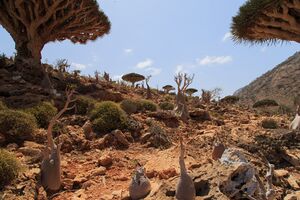
Endemism is highly notable in Socotra’s terrestrial environmental, such as 90% of the reptiles and 100 land snail species occurring nowhere else[8]. Such is unsurprising given the island’s isolation alongside its geological history. Due to its geomorphology, diverse vegetation patterns have emerged and approximately nineteen different land cover classes can be identified. Specifically, grasslands, shrublands, woodlands, forests and mangroves dominate the landscape. In regards to species composition, 825 vascular plants species can be found on Socotra, 307 of which are endemic[9]. Of Socotra's endemic plants, the dragon blood tree, Dracaena cinnabari, in the most dominant. Although this species has composed one of Earth's oldest forest ecosystems[10] and is believed to have once covered the entire island, recent observations include discontinuous woodland patches and unbalanced age structures along with a lack of natural regeneration[11]. A comparison of photographic data from 1899 to 2004 estimates a population decline of 44.22% and that younger trees have especially decreased[11]. The iconic tree’s name originates from the red sap that it extrudes from the trunk, holding cultural value as a multipurpose medicine, paint, incense and is also used in social ceremonies [12]. The dragon blood tree trunk splits upward in a vein-like pattern, creating an umbrella shape covered with a needle canopy at its ends. Only growing in regions that satisfy a specific precipitation range (207- 569 mm annual mean precipitation) [12], it can live for up to 650 years. Unfortunately due to deforestation, overgrazing, and climate change, regeneration becomes a challenge and thus threatens this uniquely Soqotri tree of extinction. The loss of any one of these trees has cascading impacts on the flora living under its umbrella-like protection, as well as other endemic organisms, such as the Hemidactylus dracaenacolus gecko, which is found only on the dragon blood tree trunk [13]. Thus, the transition of understory plants to being open-site has unknown but potentially negative impacts on overall plant biodiversity [14], which is especially alarming considering species richness is highest in the understory. Further, the presence of these trees help accumulate moisture from fog and clouds in the arid lands, making them essential in the maintenance of the island’s hydrological cycle [13].
Although the dragon blood tree has the greatest spotlight out of all the plants, other unique endemic species include; the frankincense tree, Boswellia elongata, holds cultural significance and played a big role in the economy of the past during the era of trade [13]; the cucumber tree, Dendrosicyos socotranus, with a big bulbous trunk and drastically thinner branches whose ancestry links it's origins to the Arabian mainland, where it is non-existent; the Duvaliandra dioscorides succulent, uniquely growing in dry pockets of wet granite slabs [15].
Explanation for Biodiversity Patterns
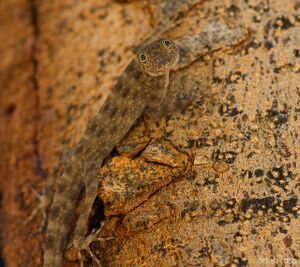
Geomorphology can be understood as a driver for speciation due to the microclimates that demand varying physical adaptions. For example, the Haemodracon geckos diverged during the mid-late Eocene to H. riebeckii, found in the elevation range of 0-200 m, and H. trachyrhiunus, found between 200- 900m[16]. It's divergence has been proven through an analysis of their overlapping habitat use and distributional range, indicating niche preferences to reduce competition on the small island and results in ecological segregation[17]. Socotra features three genera of geckos: Hemidactulus, Haemodracon, and Pristurus. Their habitual ranges overlap as do their dispersal ranges, so their divergences are evidently examples of sympatric speciation. The most noticeable characteristic of Hemidactulus and Haemodracon divergences would be the differences in body size. Such would not be an adaption to their suitable climatic range and instead allow for the two genera to occupy different niches. Pristurus has undergone the least morphological change compared to their common ancestor, however, does display changes to match climatic ranges between individual species. Therefore, Pristurus has undergone allopatric speciation and thus has the largest number of species despite also having the slowest rate of diversification[18].
Although there are 1564 endemic insect species to Socotra, this number is relatively small in comparison to archipelagos of similar size, such as the Seychelles[19]. The relatively low biodiversity of insects is theorized to be the result of the island’s arid environment as well as historical aridification events that formed an inhospitable habitat.
Human influences
Historical Role of Humans
Although Homo sapiens did originally settle Socotra in the Lower Stone Age, the first sustained human presence on the island dates back to roughly 11,000 years ago. This was bolstered by a second Neolithic colonization around 3,000 years go. These early human influences on Socotra revolved primarily around trade and colonialism. Socotra was a colony for incense production starting in the seventh century C.E. The first wave of influence was human contact and the second was after Arabian contact with European civilizations. This spurred the extraction of the island's resources for use in trading. This new interest in the island caused changes in vegetation cover and introduced pastoralism, resulting in the expansion of livestock cover. The resources on the island supplied Arab controlled incense and medicinal herb trades with aloe, dragon blood, and frankincense. Ecological changes at the hands of humans can be seen with early Greek explorers accents of the island being home to snakes, giant lizards, crocodiles, and tortoises. These are no longer found on the island, and it is known that the tortoises were hunted to extinction for the Roman tableware trade. This led to the over consumption and relocation of these species. This is an early known example of the small island biota being susceptible to human influence[20].
Changes in the Late 20th Century

In the 1990’s, Socotra’s economy underwent a number of changes. The Yemeni government wanted to modernize the economy of the region by introducing local salaried jobs, investing in infrastructure improvements, and creating a service based economy with social enterprises, namely creating an ecotourism economy to capitalize on the uniqueness of Socotra. The goal of the Yemeni government during this era was establish some level of economic self stability so that they aren’t completely dependant on government resources. In 1996 the government expanded public employment levels so that jobs became more readily attainable while also creating social and transportation infrastructures throughout the island, which connected the diaspora with the mainland. Additionally, in 1997, they launched the UN Conservation experiment, with the goal of conserving endemic biodiversity while improving socioeconomic development, all while utilizing a preventative environmental management system. These changes modernized Socotra and changed the human influences that the island sees[21].
Human Influences Going Forward
Human influences have caused habitat loss, degradation, and cascade effects on the biodiversity of Socotra. Its small population size and isolation creates the perfect environment for species to be prone to extinction, as is hypothesized in the island biogeography theory[22]. Fisheries off the coast have the potential to be at risk, but little data had been recorded in recent history.
Habitat Fragmentation and Degradation
Development of roads is a large concern causing environmental fragmentation and extinctions. This causes habitat isolation and limits gene flows of smaller species. Fragmentation from unsustainable resource uses, such as clearing and wood collection, has also occurred. Degradation stems from traditional use of cattle, sheep, and goat raising. This threatens their biota and water uses.
The construction of new roads as been particularly damaging to estuary habitats where an estimated 75% of fish species remain unidentified[7]. These roads have destroyed connections to the sea and therefore leaves the species isolated while simultaneously, their waters become increasingly contaminated with human waste.
Agriculture
Home gardens have been on the rise as development projects. These pose risks to biodiversity levels because of water provision, direct pollution, uncontrolled import of exotic species, and additional habitat fragmentation.
Overgrazing is predicted to be a cause of the population decrease for vegetative species. In particular, the dragon blood trees are experiencing a decrease in young trees due to grazers consuming them before they can fully mature[11]. These grazers, such as goats, were introduced to the island with agricultural purposes but due to a lack of land management, have been allowed to freely graze which was diminished the number of plant saplings reaching maturity.
Fisheries
The pseudo-temperate conditions of the coastline has allowed Socotra's marine ecosystems to be diverse and highly productive. The highest fish biomass/productivity levels In modern times, there has been a shift from sustainable traditionally managed, small-scale fisheries to larger small-scale and industrial scale dishing that support the population's domestic and commercial demands. Small sustainable practices have diminished. This small scale fishing is the second most important source of income and food after pastoralism. The impacts of these changes are yet to be fully understood, as minimal fisheries data is available. Currently, there is no industrial fishing actually located on the island[23].
Threats
Urbanization and Human Activities
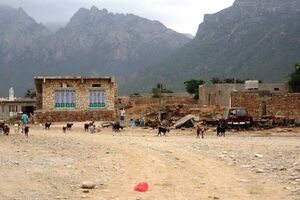
Humans put additional strain on biodiversity through resource extraction and settlement. Not only has urbanization resulted in habitat fragmentation through paved roads and infrastructure, but the lands have been degraded by the extreme grazing of goats which have long lasting impacts on the fertility of the soil and survivability of saplings[24]. Uncontrolled goat grazing was not previously an issue when traditional land management practices kept the grazing at bay. In addition, resource extraction for timber, fuel, animal feed and resin collection has specifically put the dragon blood tree population at risk and decreased the overall forest tree density. The results of current extraction practices have fragmented habitats and increase the aridity of the land where there are less trees. This has cascading effects on the organisms, such as reptiles and birds, that rely on their symbiotic relationship with the dragon blood tree for nourishment and protection.
Political Conflicts
A civil war that started in 2015 had crept into Socotra from mainland Yemen in 2020. Due to this war and other conflicts occurring in East Africa, delivering supplies to Socotra has been a tremendous challenge and hunger has become a prevalent issue on the island. In response to famine, individual commitments to maintaining the environment weakened, especially for common lands, as demand to earn a portion of the island's limited cash became vastly inaccessible to lower income groups[25]. Furthermore, the potential damage of natural disasters is magnified due to the ongoing civil war. In the span of a week, two destructive cyclones hit the island in 2015 and resulted in the IUCN asking that this world heritage site to be listed as under danger[26]. With infrastructure and the local environment severely damaged, Socotra accepted the help of the United Arab Emirates and by doing so, introduced the isolated island into the ongoing political conflict. As of the present, the UAE's military force is still active on the island.
Additionally, its location being in the Gulf of Aden off the coast of Somalia and overall isolation from Yemen's main coast also makes the nearby waters susceptible to piracy. In consequence of the lack of maritime law enforcement that gives way to the excessive use of fishing trawlers, the surrounding aquatic environments have undergone significant degradation which has also limited the available food supply to local populations. This damage has caused irreparable damage to Socotra's local biodiversity and especially to species unique to the island[25]. Political conflicts such as these render an island less accessible for researchers and less likely for conservation efforts to be prioritized, ultimately threatening biodiversity if no change in management practices are to be implemented.
Climate Change
Being mostly an arid tropical island, Socotra too faces challenges when it comes to climate change, where changing precipitation patterns and shifting seasonality puts biodiversity at risk of cascading effects. The increasing intensity of passing cyclones knock down mature trees, where the current and ongoing erosion of the soils in the dry climate already make it a struggle for vegetation to grow, resulting in decreased tree density[24]. Excessive rainfall can lead to flooding, and further soil erosion. The formation of clouds and fog around the island provide more gradual and consistent humidity to the area, bringing 5-75% of annual rainfall depending on the aridity of the area[27]. Furthermore, Socotra endures monsoons and tropical cyclones from the Indian Ocean. As water is typically a limited resource, sudden surges from these events may cause topographic destruction and by effect impact vegetation patterns[28]. To put it simply, flora biodiversity is at risk of being flooded, or further drying out. Global trends in climate change will cause significant issues for the land. Ocean levels are expected to rise 60 cm by 2100 which is especially concerning for Socotra's marine life and coastal plain ecosystems[29]. Furthermore, along the coast is where several eco-camps that serve tourism and fund local sustainability efforts are found[30].
Conservation
The Equator Initiative: Roush Marine Protected Area
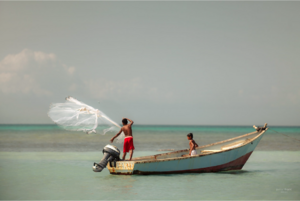
This conservation project acknowledges the successful advancements in sustainable developments that is pioneered by local, indigenous communities. In response to marine degradation that damaged fish populations, the Roush Protected Area Community was set up in the waters one kilometre off Socotra’s north coast with ownership returned to the local Sacra and Diherhom villages.
A variety of strategies have since been employed to restore marine ecosystems while benefiting the living conditions of the local residents. Between the early 1990s to 2000, a series of restrictions were set up to prohibit harmful fishing equipment and instead promote traditional fishing instruments, as well as designating no-take zones. The harmful fishing equipment includes low dragging nets and nets that harvest fish of any age. Fishing was never banned in entirety as this practice was crucial to meet the consumption needs of the local, isolated communities. Since fishing regulations managed by the local communities were introduced, an increase of fish biodiversity has been observed. With more species of fish becoming more abundant, fishermen have experienced an increase in revenue in response to greater fish stocks in the region.[31]
Conflict has previously occurred where in one event, an individual attempted to sell their section of land to an investor who initially planned to build a resort. After a discussion with the investor and community as a whole, the project changed to an eco-campsite that opened in 2009. The Rosh eco camp is situated along the shore of a coral beach and provides sustainable enjoyment such as snorkeling and diving gear, as well as palm shelters and solar panels to charge equipment[30]. The camp generates approximately 1.5 million rial on an annual basis and has created a variety of work including ten full time positions and purchasing food and handicrafts from the local communities. Traditional souvenirs made by women are also sold, an important opportunity given that in Socotra’s culture, women are excluded from public affairs. The eco-camp has provided a new source of revenue for locals while simultaneously achieving sustainability goals that include maintaining the biodiversity local plant and animal species that in turn, increases abundancy.
Dragon Blood Tree Conservation
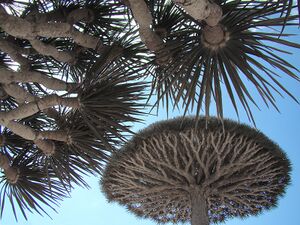
The species D. cinnabari acts as an umbrella species for flora and fauna throughout the island, acting as a biotic driver for species throughout the island while also influencing the hydrological cycle on the island [32]. Research into conservation for this species dominates the discourse surrounding natural conservation throughout the island as the current distribution of the species occupies only 5-10% of potential habitat[33]. As the importance of this species has come to light, research into the distribution of the species throughout the island and its relations [33]; research into potentially optimal conservation for maintaining the tree’s ecosystem services [34]; and local efforts to revitalize the species through aiding international research and local nurseries have all served to improve the outlook for the species [32]. By gaining an understanding into the current distribution of trees throughout the island, scientists aim to understand both the threats to the forests but also the best way to protect and regenerate the species.
Predominant techniques used for D. cinnabari conservation are remote-sensing[33] using satellites that go over the island coupled with ground truthing often provided by local Soqotri environmentalists and researchers [32]. Secondary local community-conservation is driven through local participation in remote study accompanied by grassroots efforts to cultivate young trees and protect them from goat grazing[32]. While the success of conservation research and efforts into the protection of the dragon blood trees are progressing well, they are still in their infancy as political turmoil throughout the region has prevented large-scale foreign involvement in local conservation. Local efforts, however, have proven to be somewhat successful as individuals have proven to be invaluable for developing nurseries for young forests, protected from the silvopastoralism prevalent throughout the region[32].
The Integrated Program for the Conservation and Sustainable Development of the Socotra Archipelago
Received by Global Environment Facility in March of 2013 and approved in June of 2013, the Integrated Program for the Conservation and Sustainable Development of the Socotra Archipelago is a sustainability project with a focus on Socotra. It is conducted by UN Environment in association with the Senckenberg Society for Nature Research and the Environment Protection Agency of the Government of Yemen. This project highlights the current risk to Socotra as a result of population growth, climate change, and haphazard policy making for the island. Additionally, the lack of funding for conservation efforts on the island and the need to aid the current government in its efforts spurred the creation of the venture.
The end goal of the project is to protect the current state of Socotra’s biodiversity, while preserving the Socotran identity as well as developing and providing institutions with the proper tools to self-manage the island, namely through the creation and promotion of smart policy decisions. Key components to their sustainability and management practices include invasive species mitigation, biodiversity, protected areas, and land management. The current objective for the project is to determine the likelihood of maintaining the current ecological state of Socotra. It also serves to assess risk to the island and its sensitive ecosystem functions, while simultaneously providing suggestions for future undertakings on the island by the UN Environment and Global Environment Facility.
The project also looks to promote human well being by embracing sustainable development strategies, namely providing for the Soqotri people while also not irreparably damaging the ecosystem that they inhabit. The project has been approved for implementation and ongoing since 2015[35].
Socotra Archipelago Master Plan

The isolation of the archipelago has allowed for the evolution of many unique endemic species[8][9]. In 1996, the Yemeni government declared Socotra a protected area and requested assistance from the United Nations Development Programme (UNDP), Global Environmental Facility (GEF), and the EU to prepare a long-term master plan for the sustainable development of Socotra. The Socotra Archipelago Master Plan (MP) was a product of the biodiversity project and the zoning plan, and was the first GEF-funded biodiversity project that was also formed in partnership with the UN . The main goal of the MP was to create a 10-year development plan to aid socio-economic development around the island and also highlight the need for biodiversity protection and create sustainable development parameters using preventative management strategies. This was done by creating a comprehensive systems map of human and natural resources on the island, analyzing the results, and providing advice on preserving biodiversity in conjunction with development. While the intentions of the MP were good, promises to grant Soqotri rights to the development of modern amenities on the island while protecting island biodiversity fell short. Up until about 1990, the island was mainly inhabited by Indigenous Socotran's but with the introduction of western development, they have struggled to maintain biodiversity and their traditional ways of living[21].
The results of the evaluation identified 6 main “priorities”, one being community-led environmental management. The GEF and UN’s western approaches to conservation prioritized “science-based” knowledge by identifying endemic species while disregarding the importance of traditional human activities. The final proposal for this “priority” was total regulation of the island's landmass, similar to national parks. While this conservation approach may have benefitted biodiversity, it could have potentially led to the failure to create employment opportunities from locally relevant industry for Socotran’s Indigenous population. Overall, one of the largest flaws of the MP was the failure to include Indigenous knowledge in the planning stages of the conservation priorities.
In the end, the MP was supposedly abandoned in 2002-2003 due to intentional policy procrastination, and the funding intended for the implementation stages of the MP was suspiciously reallocated to other activities in Yemen rather than Socotra. While there are a number of reasons that this MP was canceled, this decision was likely influenced by the political and economic interests of the Yemeni Government. The MP brought many environmental issues surrounding the island’s development to the surface and due to the levels of systemic corruption, the relationship between the planning department and the public works department may have played a large role in its cancellation[36].
Franklinia Foundation; Conservation of the Frankincense Tree
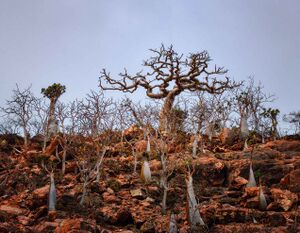
Since 2020, the Franklinia foundation project has been fighting for the conservation of Socotra’s endemic Frankincense tree (Boswellia elongata). Mainly known for its resin that burns as incense and is used during cultural practices, it is less widely known as a medicinal diaphoretic plant which promotes sweating to heal intestinal and skin ailments [37], used for over 2 millenniums. Population declines have been noted since the 1950’s, which have been accelerating in recent years. The trees are at risk due to human activities such as unsustainable resin harvesting, agricultural lands expansion, and indirectly through climate change. In the absence of humans, Frankincense trees face additional stress from overgrazing by goats, and natural disasters such as fires and a cyclone in 2015 that immediately wiped out 38% of the population, with an additional third of remaining trees dying in the following years. If these trees are not protected from extinction, we not only lose an endemic species that will never return, but the ecosystem services that they provide. Frankincense trees play an essential role in the hydrological system by retaining water and cooling surrounding areas while stabilizing the soil. For insects and animals, its structure provides shade and habitat while its flowers provide pollen. Lastly, the nutrient cycle would not be complete without its decomposing leaves that strengthen soil fertility[38] .
The foundation is taking the steps towards conservation through re-assessing populations which have not been updated since 2004[39] , replanting wild seedlings in local gardens and nurseries, and public education, all of which focus greatly on local participation and community involvement [37]. The project aims to be completed by the end of December, 2022. To date, all the listed progress has been made between January-December, 2020. An initial meeting in Rome was followed by seed collection, controlled planting, and growth assessment, which was then followed up by a conference with Friends of Soqotra, the local conservation charity. Seed germination training days for Soqotri scientists took place at the University of Brno, Czech Republic, after which germination trials began in Socotra. These processes were explained to the environmental protection authority (EPA) before building a single large nursery where seeds grew into saplings before being replanted back in their respective habitats. Reforestation projects took place in 3 towns. One dragon blood tree reforestation area was expanded to support Frankincense trees, replacing old broken fences with stone walls, and creating metal cages to encircle and protect replanted Frankincense saplings. Although detailed plans and updates were posted every 3 months, they stopped after December, 2020 with no news why the project presumably ended or was put on hold. A speculated likelihood could be related to the civil war that started in 2015 on the mainland, which extended to the island in 2020. Ultimately the project had a strong start with clear objectives and heavy involvement of the local community. The researchers successfully made a project design that included the participation of local residents gardens, and furthered the knowledge and contributions of local scientists.
References
- ↑ Brown, G., & Mies, B. (2012). Vegetation ecology of socotra. Springer.CS1 maint: multiple names: authors list (link)
- ↑ De Sanctis, M.; et al. (2013). "Classification and distribution patterns of plant communities on Socotra Island, Yemen". Applied Vegetation Science. 16(1): 148–165 – via https://doi.org/10.1111/j.1654-109X.2012.01212.x. Explicit use of et al. in:
|last=(help) - ↑ Fleitmann, D.; et al. (2004). "Geology and Quaternary climate history of Socotra". Fauna of Arabia. 20: 27–43. Explicit use of et al. in:
|last=(help) - ↑ Veettil, B. K.; et al. (2020). "Biodiversity and nature conservation in island ecosystems: spatiotemporal changes in Socotra archipelago (Yemen)". Journal of Coastal Conservation. 24(54) – via Https://doi.org/10.1007/s11852-020-00774-4. Explicit use of et al. in:
|last=(help) - ↑ Klaus, Rebecca & Turner, John. (2004). The marine biotopes of the Socotra Island Group. Fauna of Arabia, 20, 45-115.
- ↑ Zajonz, U., Lavergne, E., Bogorodsky, S. V., & Krupp, F. (2022). Biogeography of the coastal fishes of the socotra archipelago: Challenging current ecoregional concepts. PloS One, 17(4), e0267086-e0267086. https://doi.org/10.1371/journal.pone.0267086
- ↑ 7.0 7.1 Lavergne, E., Zajonz, U., Krupp, F., Naseeb, F. and Aideed, M.S. (2016), Diversity and composition of estuarine and lagoonal fish assemblages of Socotra Island, Yemen. J Fish Biol, 88: 2004-2026. https://doi.org/10.1111/jfb.12964
- ↑ 8.0 8.1 Sindaco, R., Metallinou, M., Pupin, F., Fasola, M., & Carranza, S. (2012). Forgotten in the ocean: Systematics, biogeography and evolution of the trachylepis skinks of the socotra archipelago. Zoologica Scripta, 41(4), 346-362. https://doi.org/10.1111/j.1463-6409.2012.00540.x
- ↑ 9.0 9.1 Batelka, J. (2012). Socotra archipelago - a lifeboat in the sea of changes: Advancement in socotran insect biodiversity survey. Acta Entomologica Musei Nationalis Pragae, 52, 1-26.
- ↑ Miller, A.G., Cope, T.A. (1996). Flora of the Arabian Peninsula and Socotra. Edinburgh University Press.
- ↑ 11.0 11.1 11.2 Habrova, H., Cermak, Z., & Pavlis, J. (2009). Dragon’s blood tree – threatened by overmaturity, not by extinction: Dynamics of a dracaena cinnabari woodland in the mountains of soqotra. Biological Conservation, 142(4), 772-778. https://doi.org/10.1016/j.biocon.2008.12.022
- ↑ 12.0 12.1 Saraf, Sanjay (February, 2021). "Preserving the Perishing Endangered Natural Biodiversity of Socotra Island". Open Journal of Ecology. 11: 148–162. Check date values in:
|date=(help) - ↑ 13.0 13.1 13.2 Attorre, Fabio; et al. (August, 2020). "Twenty years of biodiversity research and nature conservation in the Socotra Archipelago (Yemen)". Rendiconti Lincei. Scienze Fisiche e Naturali. 31: 563–569. Explicit use of et al. in:
|last=(help); Check date values in:|date=(help) - ↑ Rezjek, Martin (April, 2016). "Loss of a single tree species will lead to an overall decline in plant diversity: Effect of Dracaena cinnabari Balf. f. on the vegetation of Socotra Island". Biological Conservation. 196: 165–172. Check date values in:
|date=(help) - ↑ Forrest, Alan (September, 2020). "Dragon's blood and flowering bottles: exploring Socotra's magnificent plants". Bradt Guides. Retrieved November, 2022. Check date values in:
|access-date=, |date=(help) - ↑ Tamar, K., Simó-Riudalbas, M., Garcia-Porta, J., Santos, X., Llorente, G., Vasconcelos, R., & Carranza, S. (2019). An integrative study of island diversification: Insights from the endemic haemodracon geckos of the socotra archipelago. Molecular Phylogenetics and Evolution, 133, 166-175. https://doi.org/10.1016/j.ympev.2019.01.009
- ↑ Fasola, M., Razzetti, E., Sindaco, R., Ziliani, U., Delle Monache, D., Pellitteri-Rosa, D., Vasconcelos, R., & Carranza, S. (2020). Ecological preferences of the endemic reptile community of socotra. Atti Della Accademia Nazionale Dei Lincei. Rendiconti Lincei. Scienze Fisiche e Naturali, 31(3), 687-701. https://doi.org/10.1007/s12210-020-00922-w
- ↑ Garcia-Porta, J., Morales, H., Gómez-Díaz, E., et al. (2016). Patterns of diversification in islands: A comparative study across three gecko genera in the Socotra Archipelago. Molecular Phylogenetics and Evolution, 98, 288-299. https://doi.org/10.1016/j.ympev.2016.02.007
- ↑ Bezděk, J., & Hájek, J. (2017). Insect biodiversity of the socotra archipelago – underlined and counted. Acta Entomologica Musei Nationalis Pragae, 57(1), 1-39. https://doi.org/10.1515/aemnp-2017-0105
- ↑ Damme, K. V., & Banfield, L. (2011). Past and present human impacts on the biodiversity of socotra island (yemen): Implications for future conservation. Zoology in the Middle East, 54(sup3), 31-88. https://doi.org/10.1080/09397140.2011.10648899
- ↑ 21.0 21.1 Elie, S. D. (2020). A post-exotic anthropology of soqotra, volume II: Cultural and environmental annexation of an indigenous community (1st 2020. ed.). Springer International Publishing. https://doi.org/10.1007/978-3-030-45646-7
- ↑ MacArthur, R. H., & Wilson, E. O. (1967). The theory of island biogeography. Princeton University Press.
- ↑ Zajonz, U., Lavergne, E., Bogorodsky, S. V., & Krupp, F. (2022). Biogeography of the coastal fishes of the socotra archipelago: Challenging current ecoregional concepts. PloS One, 17(4), e0267086-e0267086. https://doi.org/10.1371/journal.pone.0267086
- ↑ 24.0 24.1 Riccardi, Tullia (2020). "Environmental factors and human activity as drivers of tree cover and density on the Island of Socotra, Yemen". Rendiconti Lincei. Scienze Fisiche e Naturali. 31: 703–718.
- ↑ 25.0 25.1 Lackner, H. (2020). global warming, the environmental crisis and social justice in yemen. Asian Affairs (London), 51(4), 859-874. https://doi.org/10.1080/03068374.2020.1835327
- ↑ "Yemen: As the civil war rages on, the island of Socotra battles with climate change". Minority Rights. Retrieved November 13th, 2022. Check date values in:
|access-date=(help) - ↑ Attorre, Fabio (2007). "Will dragonblood survive the next period of climate change? Current and future potential distribution of Dracaena cinnabari (Socotra, Yemen)". Biological Conservation. 138: 430–439.
- ↑ Schlote, P., & Geest, P. D. (2010). "The climate of Socotra Island (Yemen): A first-time assessment of the timing of the monsoon wind reversal and its influence on precipitation and vegetation patterns. Journal of Arid Environments". Journal of Arid Environments. 74(11): 1507–1515 – via https://doi.org/10.1016/j.jaridenv.2010.05.017.CS1 maint: multiple names: authors list (link)
- ↑ Parry, M. L., & Intergovernmental Panel on Climate Change. Working Group II. (2007). Climate change 2007: Impacts, adaptation and vulnerability : Contribution of working group II to the fourth assessment report of the intergovernmental panel on climate change. Cambridge University Press.
- ↑ 30.0 30.1 Association Friends of Socotra (2013). "Eco-Camps".
- ↑ Equator Initative (2012). "Roush Marine Protected Area Community Socotra". UNDP.
- ↑ 32.0 32.1 32.2 32.3 32.4 Craig, Jess (Oct. 12, 2022). "Saving the Dragon's Blood". Retrieved Nov. 19, 2022. Check date values in:
|access-date=, |date=(help) - ↑ 33.0 33.1 33.2 Vasconcelos, R; Pujol-Buxó, E; Llorente, G; Ahmed, S; Carranza, S (2020). "Micro-hotspots for conservation: An umbrella tree species for unique socotran reptile fauna". Forests. 11 (3): 353.
- ↑ Maděra, P., Volařík, D., Patočka, Z., Kalivodová, H., Divín, J., Rejžek, M., Vahalík, P. (2019). Sustainable land use management needed to conserve the Dragon’s blood tree of socotra island, a vulnerable endemic umbrella species. Sustainability, 11(13), 3557. doi:https://doi.org/10.3390/su11133557
- ↑ Global Environment Facility. "Support to the Integrated Program for the Conservation and Sustainable Development of the Socotra Archipelago". Global Environment Facility. Retrieved 11/22/2022. Check date values in:
|access-date=(help) - ↑ Elie, Serge. D. ""Saving Soqotra": Biography of a Conservation and Development Experiment". A Post-Exotic Anthropology of Soqotra, Volume II. Cultural and Environmental Annexation of an Indigenous Community. pp. 225–319.
- ↑ 37.0 37.1 Madera, Petr (Janaury 1st, 2020). "Conservation of the endangered endemic Boswellia trees on Socotra island". Tropical Forestry. Retrieved November 20, 2022. Check date values in:
|date=(help) - ↑ Lvoncik, Samuel (2020). Key to identification of Boswellia species on Socotra archipelago. Czech Republic. p. 1.
- ↑ Lvoncik, Samuel (July 2020). "Development of a population of Boswellia elongata Balf. F. in Homhil nature sanctuary, Socotra island (Yemen)". Rendiconti Lincei. Scienze Fisiche e Naturali. 31: 747–759. line feed character in
|title=at position 69 (help)
| This Tropical Ecology Resource was created by Course:GEOS303. |
